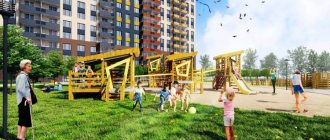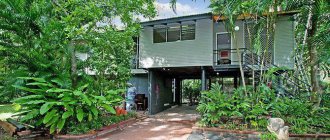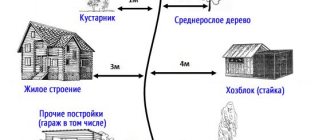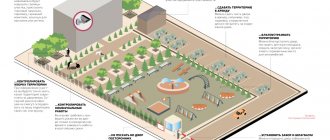Apartment
23
When purchasing an apartment, its owner is sure that all rights to the purchased meters belong exclusively to him. But few people think about what happens to the land and the real estate located on it, which is located next to the apartment building.
The adjacent territory is the territory adjacent to a residential building, defined by land management and urban planning documentation within a plot of land of a certain area.
It may contain various structures and non-residential premises necessary to meet the household needs of the residents of this house. Many people are interested in the question of how many meters is the adjacent area of an apartment building in 2021? Read more about this below.
Home improvement and local area
There are no specific standards regulating the exact size of the local area. On average, for an apartment building this equates to 3-6 meters (maybe more).
According to Art. 36 Housing Code of the Russian Federation, the local area includes :
- blind areas (waterproof coverings located around the building);
- driveway, sidewalk, planting strip along the house, as well as the one located near the facade without entrances (its purpose is to provide passage for fire trucks);
- children's playgrounds, sports grounds, as well as those pedestrian paths (paths) that connect these objects to each other;
- areas where waste bins are located;
- plots of land under non-residential commercial buildings and structures;
- parking lots where the cars of residents of an apartment building are parked;
- exits, entrances to underground garages and parking lots.
How are its dimensions calculated according to SNIP?
According to the generally accepted standard, the area of the local area is calculated based on the formula : Ster=Szh*Un, where Ster is the area of the local area, Szh is the total area of all residential premises of the house, and Un is the specific value of the land share. All standards for the local area of an apartment building are reflected in SNIP, that is, from the rules for regulating construction. The size of the yard of a multi-apartment residential building depends on many factors - the number of floors in the building, the number of apartments and other factors, as well as on the year in which the building was put into operation.
More detailed information can be found in SNiP-e No. 2.07.01/89 “Planning and development of urban and rural settlements”.
IMPORTANT. The size of the adjacent plot is determined according to the Town Planning Code.
Read about how many meters from the house and the fence the adjacent territory of an apartment building is considered, how the size and area are determined.
Registration of property
The only legally accessible and legal option for privatizing the adjacent territory today is the organization of condominium associations (associations of co-owners of an apartment building). It is important to understand that after drawing up the agreement, it does not become the property of the condominium association, but belongs to all co-owners of the apartment building in equal shares.
The condominium association is a legal entity, a non-profit organization, the main objectives of which are to improve the quality of provided public services, manage an apartment building, and rationally operate shared facilities for residents.
The sequence of transferring land into the ownership of condominiums:
- At a meeting of residents, an appropriate decision is made on the privatization of the land around the house;
- Next, you should contact Rosreestr with an application to register ownership;
- When the permission to allocate a land plot and the corresponding technical specifications are ready, you need to go to the land management organization with a package of documents.
How to hold a general meeting of residents in 2021?
What documents will be required:
- certificate of state registration of condominiums;
- the charter of this organization;
- certificate of inclusion in the All-Russian Classifier of Enterprises and Organizations (OKPO);
- technical passport for an apartment building;
- extract from the state register of ownership;
- decision of the members of the condominium association to transfer the adjacent territory to private use;
- land boundary plan.
In turn, the land management organization, based on the land division project and the documents provided by the condominium association, prepares a site allocation project. Next, the city council must decide to transfer the territory near the house to the ownership of the residents of the apartment building and approve the corresponding project.
Based on the results of all the decisions made, the boundaries of the site are drawn to the area, after which a state act on the ownership of residents of the land adjacent to the house is drawn up and entered into the Unified State Register of Rights to Real Estate.
Registration of condominiums and selection of relevant documentation are energy- and financially-intensive activities. However, this procedure has several advantages:
- Residents can independently dispose of the corresponding plot of land, monitor (adjust) the amount of payment for cleaning the local area.
- Privatization allows you to avoid unwanted buildings in the relevant area and use the territory for the needs of the residents of the apartment building.
Organization of parking near the house
Nowadays, most people have their own vehicles. Accordingly, the question of where to leave it is very relevant. Organizing parking in the local area is one of the permitted uses of land. But this requires the consent of at least 2/3 of the homeowners. If the building has an office, store, pharmacy, studio, etc., their owners must also participate in the meeting.
It will be necessary to draw up a project for the future parking lot, taking into account sanitary standards and the planned number of cars. In addition to the parking lot itself, it is possible to provide for the installation of barriers, fencing, CCTV cameras, etc. The project is coordinated with the traffic police, the land department and the town planning committee. After this, a contractor is selected with whom a contract is concluded.
The procedure for installing fences
To protect the local area from vandalism and to protect themselves, residents sometimes decide to block it completely or partially. This could be a symbolic fence to mark boundaries or a full-fledged fence with a barrier and security.
Rules and legality of construction
There are no prohibitions on fencing the local area. To do this, it is enough to collect more than 50% of the votes of residents. However, the design should not interfere with the passage of emergency services and limit their access to the territory. Otherwise, the project will not be approved by the locality administration.
If an illegal installation occurs
The erection of fences is considered illegal if the consent of at least 2/3 of the residents is not obtained. It does not matter who owns the initiative - the owners or third parties. The complaint is filed either with the housing inspectorate or with the prosecutor's office. There they will check the information and, if the fence was erected illegally, they will issue an order to demolish it. Unauthorized construction not approved by local authorities is also considered illegal.
Disposal of local land
If the land adjacent to the house has passed all the necessary procedures, then it becomes the common property of all residents (owners) of the house.
According to the norms of civil and housing legislation, they are entitled to use, own and dispose of their property. Since property is common, decisions on how to dispose of it must be made jointly.
At a general meeting, they can agree on the construction of children's or sports grounds, parking lots, installation of benches, planting of plants, advertising, and other objects on the site.
They also have the right to enter into agreements with other persons on the use of this territory on a paid basis. Residents must manage their land wisely in accordance with the requirements of the law. It should be borne in mind that they do not have the right to restrict the movement of other persons in the local area.
In addition, the passage of special services should be ensured.
conclusions
Residents of apartment buildings often do not think about the issues of ownership and maintenance of adjacent plots of land.
However, if a landfill or parking lot is set up under the windows of the house, this becomes relevant. Owners of high-rise buildings should be aware of the status of the territory near their home, the rights to it, and the rules for its maintenance.
You can find out more about who owns the local area by watching the video:
See also Phone numbers for consultation Apr 04, 2021 kasjanenko 1681
Share this post
Discussion: 5 comments
- Anna says:
09/19/2017 at 01:40So it is, at all times, residents of high-rise buildings fight for the territory near the house, but there is no one willing to improve it or clean it up. Residents of the first floors usually adjoin this territory to theirs.
Answer
- Vengerov Arthur says:
05/03/2018 at 00:58
The difficulties we have with the local area are this. that the store has practically “occupied” it and is constantly loading/unloading. We decided to install a barrier.
Answer
- Kotelnikova says:
05/11/2018 at 16:27
We have no disputes with the local area, since we simply do not have one. The fact is that immediately behind the entrances and sidewalk there is a road with busy traffic. For that, thanks to the architect.
Answer
- Idea says:
03/17/2019 at 07:08
As always: the concept is used in all legal acts, but none of them has a clear formulation of this concept
Answer
- Sergey Petrovich says:
12/17/2019 at 06:52
In our city there is a state program “Your Yard”. Residents express their participation in it by voting. Then, the city authorities improve the surrounding area (on the basis that residents pay 25 percent of the cost). And when the work is completed, the territory is handed over to the residents and they then begin to pay for the maintenance themselves.
Answer
How to organize parking
Usually, the entire parking infrastructure already exists in the PT of new houses. However, this is often not enough. For this reason, the general meeting of residents may develop additional measures for the organization of special areas intended for parking.
In this case, you should be guided by two regulatory documents - traffic rules and sanitary standards 2.2.1/2.1.1.1200-03. In accordance with the latest document, parking lots and parking in courtyards should be designed for no more than 50 spaces. Cars should not be located closer than fifteen meters from the facade of the house. Only parking lots for ten cars can be placed closer than five meters.
It is necessary to distinguish between the concepts of parking and parking. The first option involves short-term placement of the car in an unguarded area.
In this case, the safety of the property must be ensured by its owner. The second option involves the formation of an isolated area where cars are under the supervision of special personnel. In this case, the agency servicing the parking lot is responsible for the safety of the property. As a rule, parking lots are not installed in courtyards, because in this case it is impossible to ensure compliance with the sanitary standards required for such facilities.
Violations of parking rules in local areas most often manifest themselves in the fact that motorists place their cars on lawns, sidewalks or near apartment windows. For such violations, vehicle owners are punished by a fine, the amount of which is determined at the regional level. In this case, of course, you need to contact the State Traffic Safety Inspectorate for help.
Many people treat the local area as an abstraction that has nothing to do with the lives of the owners of specific apartments. This feeling persists as long as the courtyard of the high-rise building is pleasing to the eye, and the actions of people in it do not create problems for the residents of the building. People remember that this is their property when life in apartments is complicated due to the poor condition of the courtyards. At this point, knowledge of the legal intricacies of managing common property will be required. We hope that the materials posted on our website will be useful not only for getting out of extreme situations, but also for creating more comfortable conditions.
Law
The key regulations regulating issues related to the local area are:
- Housing Code, which establishes which objects belong to adjacent areas.
- SNiP, which establishes standards regarding the location of objects on a given site.
- Civil and Land Codes, the provisions of which regulate the nuances of ownership rights to real estate.
- The Code of Administrative Offenses, Article 7 of which spells out the liability provided for violations of obligations to maintain the local area in proper condition.










